PDF Version
Venture Capital Monitor - Q4 2013
646 KB, 6 pages
This publication by the Small Business Branch provides current information about the venture capital industry in Canada. The series will track trends in investment activity, report on topical research and look at key technology clusters where investment is taking place.
Note:
Starting in 2013, the data provider changed its methodology used to capture data; therefore discrepancies exist between historical figures reported in this issue and those reported in previous year‑end issues.
Introduction
This year-end issue covers venture capital (VC) activity from January 2013 to December 2013.
VC activity overview
Investment and fundraising
Substantial increase in annual VC investment
Canadian VC investment increased significantly in 2013. Total VC investment into Canadian companies in 2013 was at the highest level since 2007, with almost $2 billion invested (Figure 1). This represents a 30 percent increase in investment compared to investment levels in 2012 (Table 1). Several major transactions contributed to this gain, including the $171 million financing for Vancouver-based HootSuite Media, the largest VC deal ever for the Canadian market. Other large transactions that took place during the year include those for Ontario-based Shopify ($100 million) and Quebec-based Enerkem ($87 million).
Figure 1: VC Investment by year, 2009–13
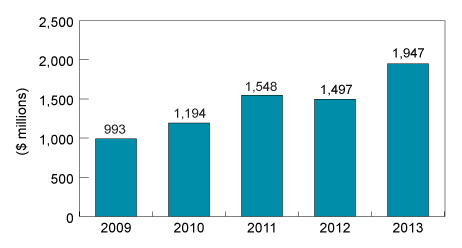
Source: Thomson Reuters Canada 2014.
| FY 2012 | FY 2013 | Percent Change | |
|---|---|---|---|
| ($ millions) | |||
| Source: Thomson Reuters Canada 2014. | |||
| Investment | 1,497 | 1,947 | 30 |
| Fundraising | 1,748 | 1,433 | −18 |
VC fundraising continued to be relatively strong in 2013, with $1.43 billion raised by Canadian funds. While this represents a decline from the $1.75 billion raised in 2012, it is much higher that the annual amounts of approximately $1.0 billion raised in the previous four years.
Deal size
Significant increase in the average deal size in 2013
A total of 463 VC deals were closed in 2013. The average deal size in 2013 was $4.2 million, which is the largest average deal size figure posted since 2007 and represents a substantial increase over the average deal size of $3.7 million posted in 2012 (Figure 2). This increase is due to a few exceptionally large deals closed in 2013 including investments of $171 million in HootSuite Media, $100 million in Shopify, and $87 million in Enerkem.
Figure 2: Distribution of VC investment by deal size, 2011–13
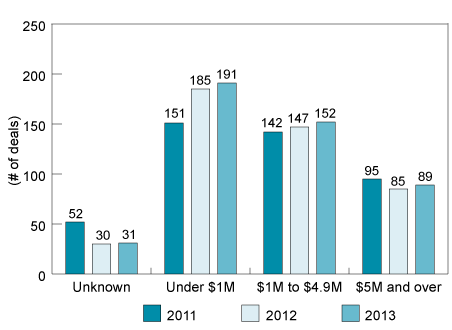
Source: Thomson Reuters Canada 2014.
The total number of VC deals under $1 million increased over the last three years, with 191 deals reported in 2013, 185 in 2012 and 151 in 2011. The total number of deals under $1 million represented close to half (41 percent) of all deals completed in 2013.
The number of VC deals between $1 million and $4.9 million changed slightly with 152 such deals reported in 2013, up from 147 reported in 2012 and 142 in 2011.
Investments of $5 million and over rebounded in 2013 with 89 deals reported. This is an increase from 85 deals in 2012, but still lower than the 95 deals that took place in 2011.
Stage of development
Investment in later stages of development grows
Slightly over half of the amount of VC investments in 2013 in Canadian companies were placed at the later stages of company development. The total value of VC investments in later stage companies in 2013 was $1.1 billion, a significant jump from $715 million in the previous year (Figure 3). Investors placed $376 million in Seed and Early Stage companies, a slight increase over the $344 million from the previous year. The investment in ExpansionFootnote 1 stage companies increased to $517 million in 2013 from $438 million in 2012.
Figure 3: VC investment by stage of development, 2011–13
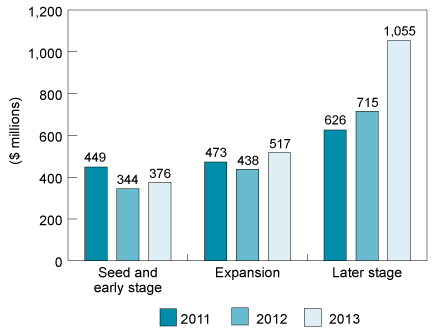
Source: Thomson Reuters Canada 2014.
New versus follow-on investments
The number of follow-on expansion investments decline
In total, 463 deals were completed in 2013, an increase in the number of companies that received VC investments compared to 2012 and 2011 (Table 2). Over the three year period, Later Stage new deals saw the most growth in the new deals category, jumping from 17 new deals in 2011 to 52 new deals in 2013.
| Total Investment | 2011 | 2012 | 2013 | |
|---|---|---|---|---|
| Source: Thomson Reuters Canada 2014. | ||||
| New | Seed and early stage | 93 | 107 | 128 |
| Expansion | 46 | 40 | 30 | |
| Later stage | 17 | 33 | 52 | |
| All | 156 | 180 | 210 | |
| Follow-on | Seed and early stage | 49 | 55 | 62 |
| Expansion | 125 | 108 | 75 | |
| Later stage | 110 | 104 | 116 | |
| All | 284 | 267 | 253 | |
| Total | 440 | 447 | 463 | |
Follow-on investments in the Expansion stage saw declines over the three year period, dropping from 125 deals in 2011 to 75 deals in 2013, while both the Seed and Early Stage and Later Stage categories of Follow-on investments saw steady growth over the same timeframe.
Type of investor
VC investment by private independent funds show strong year over year growth
With the exception of Labour Sponsored Venture Capital Corporations (LSVCC)/Retail Funds, all other investor types experienced growth in 2013 relative to 2012. Investments by private independent funds experienced the largest increase, growing by 70 percent over the period, from $521 million in 2012 to $887 million in 2013 (Figure 4). Investments by LSVCC/Retail investors dipped to the lowest value for the three year period, dropping to $61 million in 2013 from $111 million in 2011.
Figure 4: Distribution of VC investment by type of investor, 2011–13
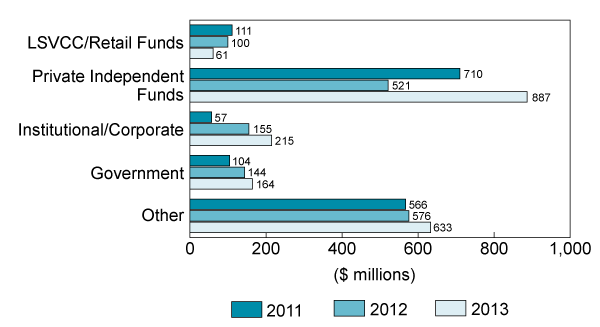
Source: Thomson Reuters Canada 2014.
Institutional/Corporate, which refers to investments by banks, financial institutions, endowments, foundations, pension funds and corporate venture funds experienced growth over the three year period, expanding from $57 million in 2011 to $215 million in 2013.
A total of $633 million was invested by funds from locations that Thomson Reuters could not disclose. This category of "Other" investors makes up approximately one third of all VC investors in Canadian companies.
Source of funds
VC investment from outside Canada jumps in 2013
Despite a slight dip in 2013, investment from Canadian VC funds lead the distribution of total investment in all three years (Figure 5). Although falling slightly to $935 million in 2013, investment from within Canada still represented approximately half of all VC investment in Canadian firms.
Figure 5: Distribution of VC investment by fund location, 2011–13
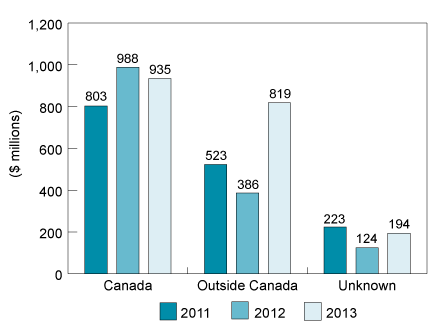
Source: Thomson Reuters Canada 2014.
VC investment from outside of Canada increased substantially in 2013, rising to $819 million from $386 in 2012. Investment from unknown sources was $194 million in 2013, an increase from $124 million in 2012.
Regional distribution
British Columbia had a substantial 138 percent increase in VC investment
Ontario firms attracted the largest amount of total VC investment among all the provinces in 2013, with a total investment of $678 million. This represents a modest increase from the previous year's VC investment of $659 million (Figure 6). These totals include the $100-million investment in Shopify in 2013, and the $80-million investment in Desire2Learn in 2012.
Figure 6: Regional distribution of VC investment in Canada, 2011–13

Source: Thomson Reuters Canada 2014.
British Columbia experienced considerable gains in the value of VC invested, with $478 million invested in 2013, a substantial 138 percent increase over the 2012 value of $201 million. A significant portion of this increase can be attributed to two large investments in Vancouver-based based firms in 2013, namely the $171 million financing deal for HootSuite Media and the $33 million investment in Celator Pharmaceuticals. VC investments in Quebec also experienced sizeable growth with the total value of investments measuring $573 million, a 42 percent increase compared to investments in 2012. Part of this growth can be attributed to the $87 million VC investment in Montréal-based Enerkem and the $30 million investment into Montréal's iBwave Solutions, which both took place in 2013.
While Ontario experienced the largest value of VC investment in Canada, Quebec led the country with the largest number of deals finalized in 2013 with 170 deals completed (Table 3).
| Province | 2012 | 2013 | Percent Change |
|---|---|---|---|
| Source: Thomson Reuters Canada 2014. | |||
| British Columbia | 57 | 62 | 9 |
| Alberta | 19 | 30 | 58 |
| Saskatchewan | 12 | 5 | −58 |
| Manitoba | 6 | 2 | −67 |
| Ontario | 152 | 161 | 6 |
| Quebec | 169 | 170 | 1 |
| New Brunswick | 10 | 16 | 60 |
| Nova Scotia | 18 | 14 | −22 |
| Prince Edward Island | 0 | 0 | n/a |
| Newfoundland & Labrador | 3 | 1 | −67 |
| Territories | 0 | 0 | n/a |
Sector distribution
VC investment in clean technology posted strong year-over-year growth
As in previous years, Canadian VC was driven by investments in information technology (IT) companies. Investments in the IT sector have increased steadily, and in 2013, $1.1 billion was invested in 252 companies in the IT sector, an increase of 38 percent since 2011 (Figure 7). This increase can be explained in part by very large deals. There were two IT deals worth over $50 million in 2013, one in 2012, and none in 2011.
Figure 7: VC investment by industry sector, 2011–13
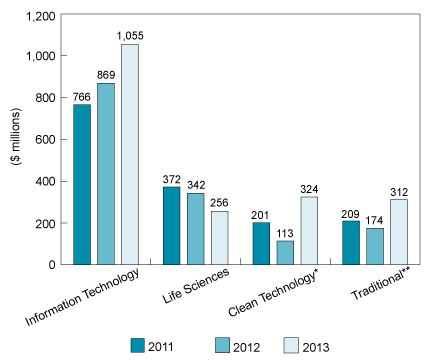
Note * Clean Technology refers to companies that are developing clean technologies and that are not already included in the industry sectors of Life Sciences or Information Technologies.
Note ** of Figure 7: Traditional refers to companies that are not included in the other sectors.
Source: Thomson Reuters Canada 2014.
The clean technology sector experienced significant growth in 2013, with VC investments of $324 million going to 38 companies. This included the $87 million invested in Quebec's Enerkem, and $48 million in Ontario's Anaergia. Although there was a decline in investments in this sector in 2012, which dipped to $113 million, the overall growth in investments since 2011 was 69 percent.
Life sciences firms saw a steady decline in investments over the past three years. Total investments in 2013 declined to $256 million from $342 million in 2012 and $372 million in 2011. This represents a decline in VC investments of 31 percent since 2011.
Government activities
Business Development Bank of Canada activities
During Q4 2013, the Business Development Bank of Canada (BDC) made VC commitments totalling $17.2 million into 27 companies (Table 4). These financings were leveraged by an additional $73.8 from co-investors for total investments of $91 million.Footnote 2
| BDC | Co-investors | Total | Number of deals | |
|---|---|---|---|---|
| ($ millions) | ||||
| Source: Business Development Bank of Canada 2014. | ||||
| Seed and early stage | 4.9 | 8.8 | 13.7 | 18 |
| Development | 5.6 | 14.9 | 20.5 | 6 |
| Later stage | 6.7 | 50.1 | 56.8 | 3 |
| Total | 17.2 | 73.8 | 91.0 | 27 |
As part of its mandate to support Canadian entrepreneurs, during 2013, BDC continued the implementation of its strategic plan for addressing gaps in the Canadian venture capital ecosystem. The BDC invested nearly $75 million in 86 direct investments in 2013, making it the largest and most active venture capital investor in Canada.
Attracting and developing top-tier fund managers
An important part of BDC's strategy included increasing its activities as a venture capital fund-of-funds, backing Canada's established venture capital fund managers as they create globally competitive investment returns by finding and backing the best Canadian entrepreneurs. In 2012, for example, BDC Venture Capital's fund-of-funds division committed $103 million to five venture capital funds, which were all active investors in 2013. BDC also financed, often as lead investor, several emerging Canadian early-stage and Series A funds, such as Version One Ventures (February 2013), TandemLaunch (August 2013), McRock Capital and BrandProject (both in December 2013).
In addition, BDC looked to attract more top-tier foreign venture capital funds to Canada if they were willing to make commitments to being an active part of the Canadian ecosystem. EnerTech Capital of Pennsylvania and Sanderling Ventures of California, which recently established offices in Canada, represent two success stories of 2013.
Investing directly in promising Canadian tech companies
A major prong of BDC's strategy has been the creation of three new venture funds that are now actively investing directly in the IT, energy/cleantech and healthcare industries. Two of these funds were launched in 2013, making an additional $225 million of new money available for promising Canadian companies.
BDC also intensified its efforts to help fill the early-stage financing gap by supporting Canada's top accelerators and most promising start-up companies. Its convertible note program, which invests an initial $150,000 in graduates of select start-up accelerators, disbursed $5.3 million in 2013 to 35 Canadian start-ups. The accelerators involved in the program are FounderFuel, Communitech Hyperdrive, Extreme Startups, GrowLab, Launch36 and Execution Labs.
Helping increase private sector investments
In a new and separate effort, BDC is also facilitating the implementation of the Venture Capital Action Plan (VCAP) on behalf of the Government of Canada by providing independent expertise, undertaking due diligence, supporting negotiations with funds and other investors, and assisting in the deployment of VCAP investments. The program is a $400 million strategy launched in January 2013 to help increase private sector investments in early-stage risk capital. The BDC VCAP structure is responsible for channelling the federal government's capital into new private sector led fund-of-funds being created, such as the Northleaf Venture Catalyst Fund, as well as directly into four existing high-performing venture capital funds selected under an open competition held in 2013.
Notes
This publication is part of a series prepared by the Small Business Branch. The branch analyses the financial marketplace and how trends in this market impact small businesses' access to financing.
To be added to the distribution list of online release of the Small Business Branch publications, please subscribe at the Subscribe to publications page.
For questions related to its content, please email: SBB-DGPE.
